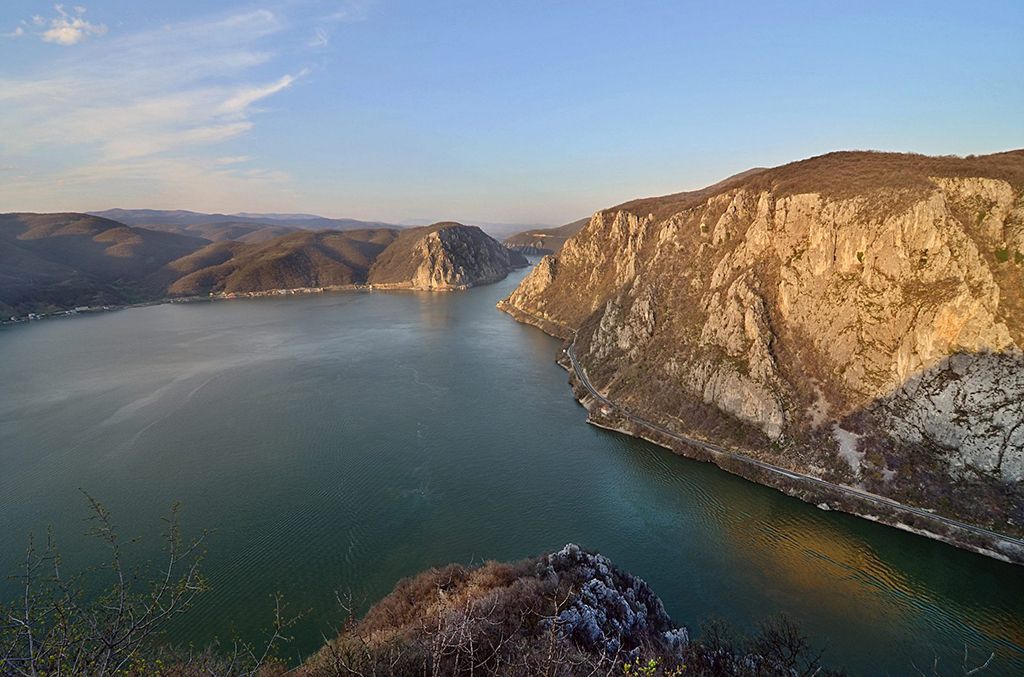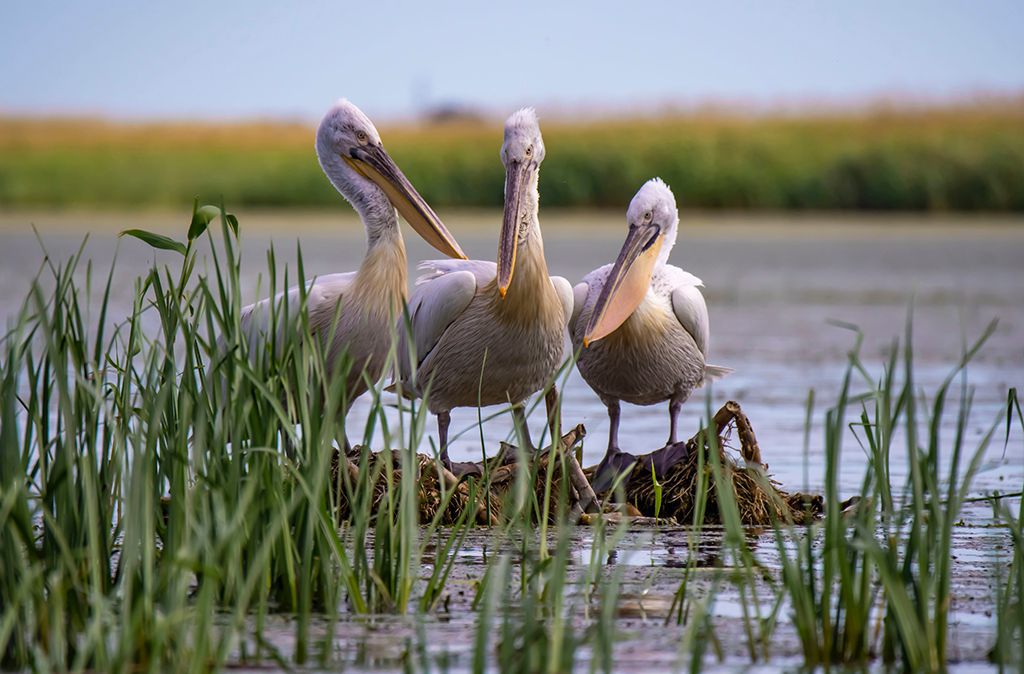 by Peter Illés on February 12th, 2023
by Peter Illés on February 12th, 2023
Two Eurovelo routes go through Romania. The EV6 and the EV13. The EV13 only adds up to 280 kilometres on Romanian territory; half of that is shared with the EV6. So it doesn't really warrant writing about it.
The EV6, though, enters the country near Naidăs and then follows the Danube for a whopping 1330 kilometres before it ends in Constanța, on the shores of the Black Sea.
It can be broken up into three distinct sections:
Of the three sections, the first and last ones are arguably the one's worth cycling. I would skip the middle section unless you really want the badge of honour that you've completed the Eurovelo 6 end-to-end.
The Iron Gates section, which is covered by one of our tours, is roughly 190 kilometres with plenty of sights and some of the most stunning landscapes along EV6.
Unfortunately, though, there is no cycling infrastructure. Hence, many choose to ride the Serbian side of the EV6 here, from Banatska Palanka to the Bulgarian border. The Serbian side is signposted and leads you on quiet roads. You may even encounter a few kilometres of bike paths (between Vinci and Golubac).
Traffic on the Romanian side is also low, except between Orșova and Drobeta Turnu Severin, where your only option is the DN6 state road. Expect many lorries and heavy traffic. If you feel uncomfortable in the traffic, we recommend you either take the Serbian side or catch a train between the two cities. Don't expect allocated bicycle spaces; technically, you're not allowed to take your bike with you. Still, you'll get away with it).
You'll have plenty to see if you decide on riding the Romanian side. The section between Baziaș and Moldova Veche takes you downstream along a peaceful, slowly flowing Danube. In Moldova Veche, it's worth jumping on a boat and visiting Ostrov Island, home to wild horses. If you're open for a short detour, visit the picturesque village of Sfânta Elena, the oldest village in Banat still inhabited by Czechs.
Stop after Coronini to check out Golubac Fortress across the Danube. If you look behind, you see another castle perched on the hill, Lászlóvára, currently under restoration. As you head towards Dubova, you might spot a couple fortress remains emerging from the river, Drencova Fortress and Tri Kule.
Dubova is a great place to spend the night, as there are many options for accommodation and plenty of things to do nearby. Get a boat ride from the giant Decebal sculpture into Veterani Cave. There you can walk through the cave and out the other side, from where you can hike up the Ciucarul Mare, a hill which will give you the most spectacular views of the gorges.
Orșova used to be a charming little town before its old town was submerged following the construction of the Iron Gates dam. If you decide to mix it with the trucks on the state road toward Drobeta Turnu Severin, you can make a short pit stop at the Iron Gates Hydroelectric Power Station and its museum.
It's also worth visiting Băile Herculane, just a short detour from Orșova. It's a spa town in the beautiful setting of the Cerna Valley. The earliest baths were built by the Romans. The city had its second golden age during the Habsburg rule when it became a favourite spot of the royals. Unfortunately, the town is dilapidated but still worth visiting.
If you decide to ride the Serbian side, you'll be able to visit Golubac Fortress, now fully restored. Lepenski Vir is a mesolithic archeologic site where several houses and cobblestone sculptures have been excavated. If you're into hiking, going up the Ploçe viewpoint will reward you with excellent vistas of the Danube gorges. Oh, and you'll be able to ride through plenty of tunnels.

View of the Danube Gorge from the Ciucarul Mare, Iron Gates, Romania.
There will be plenty of guesthouses along this stretch to choose from. Expect to pay between 25 and 50 EUR. I'd spend my first night in Sfânta Elena getting to know the history of the Czechs in Banat and then spend another night in Dubova, right next to the Danube's Big Boilers.
We only know of a single arranged camping site, Camping Mala, before the village of Eșelnița. There are plenty of wild camping options, though.
Make sure you check out our Iron Gates of the Danube tour.
Every village has small shops called "magazin mixt", where you can get food and drinks. In some places, they can be easily mistaken for bars (because they double up as one). Pharmacies will be harder to come by, so make sure you stock up in larger towns.
I know of no bike shops along the way. Your best bet will be in Drobeta Turnu Severin, which has a bike repair shop called La Pedale and Hervis Sports shop.
I have never actually visited this section on a bike. Having driven these roads, I can honestly say that I haven't missed much. Many agricultural lands to ride past, far from the Danube most of the time.
Although a large portion of this stretch is on state roads, traffic is not too intense.
The Romanian side of this section (I don't know anything of the Bulgarian side.) doesn't boast any worthwhile sights. If you want a city break, Ruse on the Bulgarian side has a nice old town.
From Călărași, the Eurovelo 6 crosses the river south, and after a short while, it turns north towards the Danube Delta. Expect this third section of the EV6 in Romania to be quite hilly in some parts.
Most of the roads along this section are backroads with little traffic. The exception is the roads around larger towns like Brăila or Galați and the coastal roads in Mamaia. I actually would recommend not following the Eurovelo between Dăeni and Brăila, but instead, take the ferry to the Big Island of Brăila from Ostrov to Frecăței and then ride on the island until Brăila. The island itself is a fisherman's paradise and prime agricultural land.
Your first sight is going to be in and near Cernavodă. The town is famous for hosting the only nuclear power plant in the country. The city's main sight, though, is the Saligny Railway Bridge, which used to be the longest bridge in Europe at the time of its completion.
Most of your sights will be in the Danube Delta. The wetlands and waters here hosts the most diverse natural ecosystem in Europe. Over 300 species of birds, 130 species of fish and 1150 species of plants can be found in this magical land of waters.
Get lost in the canals (Actually, don't. It can get dangerous as many channels can close and open with the tide. Hire a local guide instead!) and explore the many tiny fishing villages in the Delta. Boating and kayaking options are available. Visit the mystical Letea Forest with its virgin forest of poplar trees standing out of the water.
Spend a day at the seaside town of Sulina and check out the lighthouse before heading south toward Constanța. Along the way, you can visit Enisala Fortress and the old roman ruins in Histria. Sip a glass of Dobrogea's famous Murfatlar wines.
Your trip will end in the seaside city of Constanța, known as the country's access to the sea with its vast harbour. Make sure you check out the seaside promenade and the casino building, the symbol of Constanța.

The Danube Delta is the largest remaining wetland in Europe, home to over 300 species of birds.
You'll have plenty of options in the Danube Delta and along the coast. Several options will be available in larger towns as well.
Arranged camping spots are also plenty in the Delta and coastal regions. Wild camping is possible everywhere except in larger towns.
Brăila, Galați, Tulcea and Constanța all have several bike repair shops.